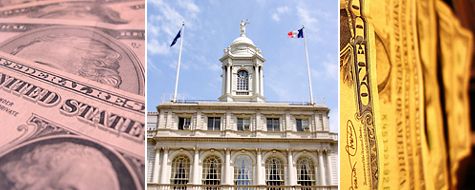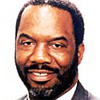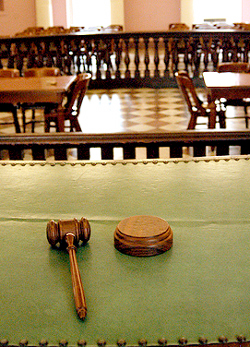Salaries For Elected Officials
What job pays at least $90,000 a year and still leaves enough free time to earn hundreds of thousands of dollars in additional income?
It is the job of a New York City Council member - or at least it is for one. Brooklyn Councilmember Dominic Recchia, who makes $90,000 a year in council salary and an additional $10,000 for chairing the council's cultural affairs committee also earns about a quarter million dollars or more in outside income, according to city documents.
What city government job pays $150,000 a year and provides a car and driver, but has no real power over city policy?
There are at least six such jobs: public advocate and the five borough presidents, who were stripped of most of their authority years ago, but whose positions remain nonetheless.
This summer, there is a debate over whether or not these elected officials deserve a pay raise.
Click here for more information about councilmembers' outside income. |
Michael Bloomberg recently appointed a commission to consider the compensation for the office of mayor, comptroller, public advocate, borough president, district attorneys, and members of the City Council.
The commision will consider factors like:
. The cost of living in New York
. What similar positions in the private sector pay
. Additional stipends for council members
. If it is a full-time or part-time job
. The amount of time since the last raise
And then they will make a recommendation to the mayor in July.
Proponents of a salary increase argue it has been seven years since local officials got their last increase.
"I think its time for the council to get a raise, yes," City Council Speaker Christine Quinn recently told the New York Post editorial board.
But critics question the rationale and the process.
For one thing, the City Council gets to vote for its own salary increases. It is also the only elected position that is allowed to be part time. About a quarter of the members also earn outside income - as lawyers, investment bankers, and political consultants, and one is a foot doctor.
The debate raises a difficult question: How much should public service pay?
COST OF LIVING IN NYC
New York City is one of the most expensive cities in the world. Money Magazine calculates that the cost of living in the city is 138 percent more than the national average. In turn, New York City elected officials are among the highest paid in the nation.
Currently, the salaries for local officials are:
- Mayor $195,000
- Comptroller $160,000
- Public Advocate $150,000
- District Attorney $150,000
- Borough President $150,000
- Council Member $90,000
However, the median income of all workers in New York City is only $41,509 - which means that the mayor earns five times more and a City Council member earns more than two times more than the average New Yorker.
Some believe this is plenty.
"I'm fine with $90,000," said Queens Councilmember Tony Avella. "I think that is enough."
But others argue that most elected officials work long hours and make decisions that affect millions of people - and that higher salaries help attract the highest caliber of people, especially in a city where many expect to - and need to - earn high wages.
"The salaries do not compensate for the time and effort and energy needed to serve," said John Zaccone, who works for the Staten Island Borough President and was one of only three people to testify at a June 1 hearing on the issue. "The salaries must not act as a deterrent to qualified people seeking public office."
PUBLIC VS. PRIVATE SECTOR
Michael Bloomberg accepts just $1 a year as the mayor of New York City. Because of his personal wealth, he has the luxury of refusing a city paycheck.
But most politicians need to pay the bills while they engage in public service, which invariably sparks a debate when the issue of compensation arises: How much is an elected official worth?
One way to think about the issue is to consider what similar jobs in the private sector pay. By this measure, many elected officials are underpaid.
At $195,000 a year, New York City has the highest paid mayor in the nation, but he is the boss of more than 300,000 city employees. CEOs of smaller corporations make many times more; the chairmen of Lehman Brothers, Merrill Lynch, and Goldman Sachs, for example, each earn more than $30 million a year.
District Attorneys, who currently make $150,000, only earn about the same as a first year associate at a private law firm. Some good government groups and newspaper editorial boards have urged a pay increase for prosecutors.
"The compensation for the district attorneys should be increased by a greater amount than for other offices given how low the pay is for those who are members of the legal profession in service to the city," Dick Dadey of Citizens Union (the sister organization of Citizens Union Foundation which publishes Gotham Gazette) recently testified.
However, it is difficult to compare jobs like the public advocate or borough president, which have little powers over city policy or the budget. They spend much of their time advocating for certain causes, serving as government liaisons, or acting as cheerleaders for their communities.
Critics who have argued that these government jobs should be eliminated are particularly opposed to giving them raises.
"The $150,000 salary is a gross overpayment for the worthless post of public advocate," the Daily News editorial board wrote.
Still others argue that public service is fundamentally different than working in private industry. People should be motivated by a desire to help others, they say, not by money.
"Public service has never been about becoming rich unless you are corrupt," Blair Horner of the New York Public Interest Research Group argues. "It's supposed to be about serving the public, by definition, and the gratification is not monetary."
SHOULD COUNCIL STIPENDS BE BANNED?

The City Council Speaker has power to give members stipends - also known as "lulus" - in addition to the base salary of $90,000 a year.
Currently, 46 of the 51 City Council members receive stipends. They range from $4,000 to $18,000 for serving as chairs of various committees. Some earn additional stipends for leadership positions ranging from $5,000 up to $28,500 for Council Speaker Christine Quinn. (Click here for a full list of salaries and stipends.)
Bronx Councilmember Joel Rivera earns an additional $23,000 a year for chairing the health committee and for serving as majority leader, a title that carries no real responsibilities other than, as the rules state, "appointing party officers as he deems appropriate." The lulus bring his total annual salary to $113,000 a year.
There is also Deputy Majority Leader Leroy Comrie (who earns an additional $20,000), and Assistant Majority Leaders Bill deBlasio and Lewis Fidler (who each earn an extra $15,000) and Majority Whip Inez Dickens (who earns an additional $11,000). And it is not just the Democrats who enjoy the lulus. Two of the three Republicans in the council also have leadership roles. James Oddo earns an additional $18,000 as the minority leader and Dennis Gallagher earns $5,000 for being the minority whip.
All told, the council members approved a total of $479,500 in stipends for themselves this year.
Some critics have called for an end to the practice because it gives the speaker power to dole out money or take it away from those who grow too independent - and it is a way for council members to boost their own salaries without going thorough the proper process.
"Why not have any salary increases tied to the elimination of stipends, which can be used to punish or reward members?" said Gene Russianoff of the New York Public Interest Research Group.
IS IT A FULL-TIME JOB?
All elected officials are required to work full-time and are not allowed to earn outside income from other jobs, with one exception: members of the New York City Council.
At least 17 of the 51 current City Council members earn outside income from law firms, political consulting jobs, apartment rentals, or pensions, according to records from the Conflict of Interest Board.
Although the financial disclosure forms that the council members are required to fill out only list a range of earned income and not the exact amount, the records show that a half a dozen council members make close to a quarter million dollars a year in income. (Click here for a complete chart of information on the additional income earned by the current members of the City Council.)
In 2004, Brooklyn Councilmember Bill deBlasio made somewhere between $5,000 and $35,000 as a consultant for John Edwards' failed president campaign.
The same year, Brooklyn Councilmember Kendall Stewart made at least $60,000 working as a podiatrist.
Queens Councilmember David Weprin, who chairs the finance committee, made at least $110,000 in additional income from his work as a lawyer and investment banker. And Bronx Councilmember Oliver Koppell earned at least $141,000 in outside income from his law firm and pension payments from his time in the State Assembly.
Brooklyn Councilmember Dominic Recchia is the biggest earner in the council. In 2004, Recchia made somewhere between $210,000 and $570,000 in addition to his council salary from his law practice as well as rental and sales income from properties in Stratton, Vermont.
The exception that allows council members to earn outside income dates back to a time when there were fewer members and they had little power. Today, however, each council member represents approximately 157,000 people and votes on legislation, the city's $50 billion budget, and land use items.
Some believe it should be a full-time position.
"Just ask my wife, this is not a part time job," said Councilmember Joseph Addabbo, who estimates he works 12 to 15 hour days, six or seven days a week and recently introduced a resolution that would designate the council position as a full-time job.
Still, while many council members want to do away with the stigma of it only being part-time, most are reluctant to limit their colleagues' ability to earn outside income.
"I didn't want to jam this law down anybody's throat," said Addabbo.
This year, good government groups support a modest pay increase for council members, but also called for making the job full-time and eliminating council stipends.
DO THEY NEED A RAISE NOW?
In New York City, the salaries for local elected officials are supposed to be reevaluated every four years through an official process. The mayor appoints a three-member commission with a name as obscure as its task: the Advisory Commission for the Review of Compensation Levels of Elected Officials.
Over the next month, the commission will consider factors like cost of living, trends across the country, and the responsibilities of the officials, and make a recommendation on salary changes to Mayor Bloomberg by July. The mayor can accept, reject, or modify the recommendation. It then goes to the City Council for a vote.
In the past, some politicians, who recognize that the subject of pay raises is touchy, have ignored the commission's suggestions.
In 1995, elected officials were given across the board increases, but Public Advocate Mark Green refused to accept the $20,000 increase because he was being forced to lay off members of his staff because of cutbacks.
In 1999, five City Council members voted against a 28 percent pay increase for themselves, some calling it "unconscionable" and a "windfall" for politicians (although the measure passed and they still accepted the extra money).
And in 2003, billionaire Mayor Michael Bloomberg decided that the city's budget woes were so bad that he refused to even appoint a commission as required by city law, and instead postponed it.
But now that the city's fiscal situation has improved - and the next local election isn't until 2009 so voters who are angered by any pay increases are likely to forget by the next election day - most observers believe there will be some kind of pay increase this year.
Under the rules, current council members will vote to increase their own salaries. Congress as well as representatives to the State Legislature are only allowed to vote for increases for those people elected in the next term to prevent such a conflict.
Critics also scoff at the notion that elected officials haven't had a raise in seven years. Because of term limits, most haven't even been in office that long.
Manhattan Borough President Scott Stringer took office in January. Of the 51 council members, 34 members have been in office for only four years, and eight have held office for just six months.
"It's a safe bet none of them campaigned in November on a pledge to raise his or her own salary," argued the Daily News editorial board.
Additional reporting by John Pham, Daniel Rivoli, and Shoshana Schwartz
Related Links:
2006 City Council Member Salaries and Stipends
Non-City Income for NYC Council Members - 2004
Advisory Commission for the Review of Compensation Levels of Elected Officials
Â
New City Council Bills
At its most recent meeting on May 24, 2006, the New York City Council passed several bills that made taxis more accessible to the disabled and more environmentally friendly.
Members of the council also introduced more taxi-related bills, as well as bills on smoking, cell phones, and POW/MIA flags.
TAXIS
According to the Council, many people in the taxi industry lack sufficient knowledge of the benefits of clean air vehicles. Several council members sponsored a bill (Intro 352) that would require that the Taxi and Limousine Commission to conduct an education campaign explaining the virtues of hybrid vehicles to taxicab owners. The bill also would require the commission to approve at least one more hybrid-electric car model that could be used as a taxi.
The Council introduced a related bill (Intro 353) to require clear identification marking clear air taxis, as well as increased public information concerning the vehicles.
Finally, a bill was introducing calling for the creation of a Central Accessibility Dispatch System (Intro 356), which would to allow the public to find taxis with access for disabled passengers by calling 311.
TOBACCO
Tobacco use costs the City almost $300 million per year in direct costs, in addition to the foregone income of workers who miss work due to smoking-related illnesses, according to a study by the Columbia University Center on Addiction and Substance Abuse. According to New York City’s Bureau of Tobacco Control, 25 New Yorkers per day (over 9,000 per year) die of smoking-related diseases.
Ninety percent of these smokers began the habit before twenty-one years of age, according to the American Lung Association. Now Councilmember Joel Rivera wants (Intro 360) to raise the legal age of buying tobacco in New York City to twenty-one. According to Rivera, this bill would “help prevent the initiation of smoking by teenagers and improve the general health of all New Yorkers.”
The legal age for purchasing tobacco in New York is set at both the city and state level. The state sets a minimum age at which tobacco can be purchased. All cities must enforce this standard, but they are permitted to set their own, more stringent laws as well.
CELL PHONES
Most electronic devices – including cell phones – have been banned in city schools since 1988. But these laws were rarely enforced until this spring, when Mayor Bloomberg and Schools Chancellor Joel Klein announced that mobile metal detectors would be randomly set up in schools. This move angered many students and parents, who said that, for many students, carrying a cell phone is a safety issue.
Councilmember Lewis Fidler and the City Council recently entered the fray, introducing a bill (Intro 351) to allow schoolchildren to carry cell phones to and from school.
[See “Hanging Up on Parents?” and “Cell Phone Ban Angers Students” for more on the cell phone controversy.]
POW/MIA FLAG
In an attempt to make sure that children respect the sacrifice of combat soldiers, Councilmembers James Oddo and Dennis Gallagher have proposed a bill (Intro 358) requiring the display of the Missing In Action/Prisoner Of War flag on all Department of Education properties where the American flag is flown.
“You learn the main subjects [in school], but you also learn main values, and one of those values is that we honor our soldiers past and present, and honor their sacrifices,” said Christopher Decicco, a spokesperson for Councilmember Oddo.
The Department of Education would be required to pay the costs of the flags, whose exact price is uncertain. In 2003 the Council passed a similar bill requiring that the Parks Department display the POW/MIA flag in about 800 public locations. Spokesperson Decicco feels that the new bill is similarly uncontroversial.
Â
Giving Voters Real Choices
In January, Judge John Gleeson ruled on the case Lopez Torres vs. the New York State Board of Elections, which held that highly qualified candidates for Supreme Court deemed to be not sufficiently loyal to the party are unable to secure the nomination in New York.
Margarita Lopez Torres ran for civil court with the support of the party in 1992 and later decided that she wanted to run for Supreme Court. After she got her seat on the civil court bench, she was given instructions from the county leader to hire a particular court attorney. Lopez Torres determined that the particular court attorney was not qualified for the position and refused to hire him. When time came for the Supreme Court nomination, she was told that the party needed loyalty – that those who stand by the county party can move on to the Supreme Court, those who do not stand by the party, cannot.
In the brief to the court, the defendants do not argue that the convention system serves judicial integrity or judicial independence. They do argue that the system serves the party associational interests and an interest in racial, ethnic and geographic diversity.
The first interest – the party’s rights to freedom of association – does not, in our view, include its right to exclude its own members from the nomination process. And geographic diversity can be addressed without burdening voters’ rights simply by imposing residency requirements on the judicial candidates, which do not now exist, or by reducing the size of the judicial districts, so that there would be smaller districts from which each judge would run. Racial diversity is a serious interest and whether or not the system in place or other alternatives created will be a great concern.
SHAM ELECTIONS
|
Related Articles: Selecting the Most Qualified Candidates Creating A Diverse Judiciary |
We begin with the premise that sham elections are not consistent with democracy. And sham elections are what we have under the current convention system. Our state constitution requires that our Supreme Courts judges must be elected. But the convention system allows the county leaders to usurp from the voters the power to select the justices.
During the course of the litigation, for example, evidence was entered that the New York County Democratic leader said that he had the votes to “kill someone.” In other words, “I can’t guarantee that I can always make you, but I can surely block you.”
That means that nobody becomes a Supreme Court justice unless the county leader agrees. In fact, after 13 days of hearings, 24 witnesses, and 10,000 pages of evidence, there was no evidence of a single person ever becoming a Supreme Court justice over the objection of a county leader. Between 1994 and 2002, 96 percent of all Supreme Court nominations statewide were completely uncontested.
In our view, if there are going to be elections in New York, then voters should have some real choice in selecting who is going to be on the bench. Now, whether there should be elections at all in New York is a different question, but in this case, the defendants argued that there is no right to meaningful participation in judicial nominations. To me, that is tantamount to the claim that meaningless participation is enough.
Having political parties control who is nominated to the Supreme Court is not consistent with judicial independence, impartiality or integrity.
AN ARGUMENT FOR PRIMARY ELECTIONS
The district court preliminarily enjoined the operation of the convention system. That means that until trial or until the legislature changes the system, the convention system is not in force. The original injunction would have defaulted to the fallback process in the statute, which are primary elections.
There were primary elections many decades ago, the convention system was put in the place, and so when the judge knocked down the convention system, he simply did what he deemed to be the least intrusive thing he could do, which was to reinstate the process that existed before.
This is the first real opportunity in decades to revisit the issue of how judges should be selected. If this decision is upheld on appeal, it will probably be the last opportunity we will have for decades. The party leaders have controlled this process for many years and unless we have an opportunity now, it is unlikely that will ever be able to persuade them to change.
The Brennan Center has not taken a position that open primaries are the best decision. We have not taken a position as to what we think the best system is. We believe there is more work to be done before we can make that decision.
The problem with the current system is that the party leaders control the selection. I am concerned that just tinkering with the system is going to replicate the problem.
More formal screening panels, for example, would not eliminate loyalty tests. Candidates will still know that at the end of the day, that the party leader will have the power to block the nomination. As long as that is the case then we have not addressed the constitutional problem.
As long as there is a system that allows the party leader to exercise that veto, we are still going to have highly qualified candidates who are going to self-select themselves out of the process.
So the candidates who come before the commission will not necessarily be the most honest, most competent, the people with the highest ethical standards. They will be the people who know that they can make a case to the party leader.
RESPONDING TO FOUR CONCERNS ABOUT ELECTIONS
The alternative – primary elections – should not be evaluated as a fallback system alone, but in terms of what they could be if there were appropriate amendments.
1. Money
The first concern about primary elections for Supreme Court is the cost. Some worry that quality candidates who either cannot or do not want to raise large sums of money will not run for office, or that they will be outspent by self-financed candidates. Public funding would address most of this issue.
We have done studies of judicial races and the cost of campaigns across the country, and we have found that the most expensive races are for the high court seats. People are spending millions of dollars on judicial races where there is no higher body in the state to overrule the judge, so it is a very important policymaking position. But we are not seeing, for the most part, very expensive trial court races.
2. Geographic Diversity
Another concern is geographic diversity, and reducing the size of judicial districts would address this issue. If a candidate can run in a single county, then candidates are not in the position to beg for scraps from the leader from the most powerful county.
For example, people in Staten Island have to convince the Brooklyn party leader that they deserve a seat on the bench. If Staten Island had its own district, they would have a much better opportunity to have geographic diversity.
3. Women on the Bench
On gender diversity, the Women’s Bar of the State of New York has submitted an amicus brief in support of the defendants in the case. They do not address the underlying issue of constitutionality, but some members are concerned that the move from a convention system to primarily elections will depress gender diversity in New York State courts. They argue “women will not be able to compete on equal footing with historically more politically entrenched candidates for Supreme Court justice.”
I find this ironic because right now women are at the mercy of politically entrenched, male party leaders.
I don’t think that they are likely to be facing greater entrenchment in an open primary. In 2002, the New York State Judicial Committee on Women in the Courts found that only 17 percent of Supreme Court justices were women. Even in New York City, 26 percent of Supreme Court justices were women, where as 47 percent of Civil Court judges were women. Civil Court judges run in primaries countywide, just as Supreme Court judges would have to do.
4. Racial Diversity
I also want to talk about racial diversity. In 2001, 92 percent of the Supreme Court justices of color in the state were from New York City. Even in New York City, from 1992 to 2002, people of color held 39 percent of civil court seats, but only 27 percent of Supreme Court seats. So in New York City, where we have majority populations of color, there is reason to believe, especially if there is public funding, that communities of color will be able to elect judges.
AN OPPORTUNITY FOR CHANGE
The one thing that public financing and smaller districts would not address is the fundamental question of whether the election of judges is appropriate in the first place.
Many people believe that institutionally the judiciary is not designed to answer to the tyranny of the majority and that the election process is fundamentally flawed. I’m not sure I agree with that. But even if you do believe that, now is an amazing opportunity for people of the state of New York to engage in a discussion about what is the best system.
Deborah Goldberg is the director of the Democracy Program at the Brennan Center for Justice
Â
 Domenic M. Recchia
Domenic M. Recchia G. Oliver Koppell
G. Oliver Koppell David I. Weprin
David I. Weprin Michael E. McMahon
Michael E. McMahon Lewis A. Fidler
Lewis A. Fidler Kendall Stewart
Kendall Stewart




